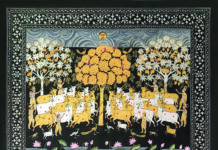Tacit knowledge sustains India’s informal economy, preserving ancient wisdom vital for cultural identity and economic resilience.
The recent Prada’s Spring/Summer 2026 show at Milan featured footwear strikingly similar to India’s Kolhapuri sandals triggering an online backlash about designers not giving due credits to the design’s origin. The social media backlash was only what it was meant to be–an emotional outpouring–we can’t expect it to help us understand why India keeps inspiring the best creative and the most organized industry abroad but struggles to uplift its context back home.
A non-confrontational and solution-oriented assessment of this problem could begin by correcting a misplaced understanding about India’s informal economy that’s predominantly unorganized–this unorganized economy can also be rightly understood as our civilization’s economy surviving and resilient because of its tacit knowledge systems.
Knowledge is explicit or it’s tacit (अनकही या निहित). Between the explicit and the tacit all spheres of our knowledge systems can be divided, permeating our history, economy, politics and possibly everything. This is undeniable in nations like India with extensive civilizational heritage as things in such societies can be very old, visible and yet inexpressible or tacit.
Thus if an European or American fashion designer or even an Indian from one of the National Institutes of design (these societies and institutions represent explicit knowledge based ecosystems), loitering through ethnic bazaars of Indian tourist towns, picks up an idea amply existent in the tacit knowledge around, he can simply credit it to his inspiration. Haowever his output, a product or a design will become the part of his organized market with no credit or returns to the source of origin.
The concept of tacit knowledge can be even translated as what in our cultural context we call “samskara (संस्कार)” and it happens inherently by means of living in a life-setting. Anytime in history a certain system of literacy or knowledge system ends, its explicit knowledge gradually and increasingly becomes tacit.
Clarity on this domestic context is particularly important for our policy makers because it can help us to understand many historical aspects of our society’s existence which continue to operate and impact our contemporary setting particularly our informal, traditional economic systems and markets.
Context of Our Informal Economy
Over 85 percent of the Indian labour or over 476 million people as of 2019-20 were employed in the informal sector contributing almost half of our GDP. Those who see formalization as the only way to economic development feel frustrated juggling these statistics–India’s formal economy is growing and is visible in our economic rise but our informal economy has continued to persist all these decades maintaining its space, strength and size.
This informal economy is characterized by time-grown and time-tested tacit knowledge systems that have come from different periods (some extremely old) and have persisted despite many challenges and catastrophes. They are existent in traditional markets by virtue of history and by virtue of being either transmitted in a lineage or being preserved in the community.
These tacit systems which many times have been cultivated by time in specific cultural geographies are also amply visible in ethnic markets of ethnic tribes. On one hand these tacit knowledge systems are found to be important for industrial innovation and creativity by cultural geographers like Meric Gertler, on the other hand they are found to prevent the transformation of informal markets into formal systems and there are research studies on the Indian informal footwear industry to prove it.
Formal or organized, regulated systems call for explicit or codified knowledge systems including for purposes of policy making. Our policy making for the informal sector is limited to social security while formal systems are more regulated with diversified investment areas including more focus on their research and development as well as the growth of their human resource.
Let’s juxtapose this perception with the Kolhapuri ethnic footwear industry which its district administration identifies as small scale (MSE). It lists 15 cooperative societies of Kolhapuri chappals in the district employing thousands of people who manufacture the ethnic traditional product both for export as well as the national domestic market.
India’s Sahkarita or cooperative mission for the informal markets is visible here and so is the visibility of the concept of cultural geography in the localization of this industry in Kolhapuri. And the fact remains that the Kolhapur footwear industry is largely family based enterprises employing tacit knowledge systems.
Tapping into Tacit Knowledge
The methods and modes of preserving tacit traditional knowledge aren’t explicit like those maintained in formal economies through research and development. In fact it largely goes unidentified, untapped and is rapidly being lost with massive demographic shifts and migration while we still struggle to understand why our informal markets are averse to transformation.
If we don’t find a way to preserve, evolve and find inspiration in the tacit knowledge systems of our traditional markets and informal industries like Prada seemingly did, we’ll lose much more than what we gain by formalization and its affluence. In fact, since what we lose will itself be tacit–it’ll only reflect in never before heard problems and existential crises.
Formalized markets will always be prone to larger manipulation triggered by geo-political trends like the current trade conflict between US and China. In geo-political and political context, I tend to think that large-scale transformation of informal economies isn’t possible without demeaning and destructive natural catastrophes, widespread civil unrest or authoritarian policy reforms. In a way India’s resilient informal sector proves the inherent value system of Indian society.
I believe, the fundamental change needed in India’s perception is in the way it has tried to understand its informal/unorganized sector more as a liability than as an opportunity. We need to think fresh and more seriously about our identity and existence as a civilizational economy and how to tap into its massive resource of tacit knowledge.
Now there are lots of opportunities and challenges for India here but this article isn’t a single-stop solution–this is something that’s going to occupy my mind for long and I hope to find some co-explorers on this journey who share this love and understanding about India. Let’s blaze a new path!
* Venus Upadhayaya is a doctoral fellow studying various perspectives to India’s unorganized economic sector. She’s also a senior journalist and a MOFA 2025 Taiwan Fellow.








